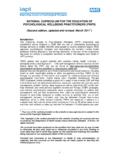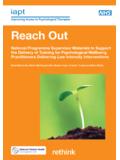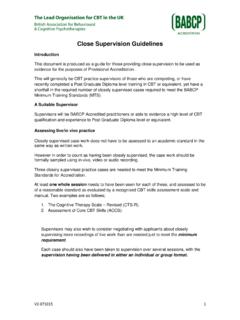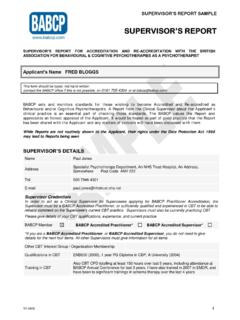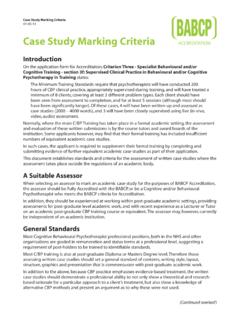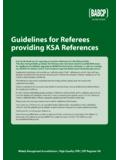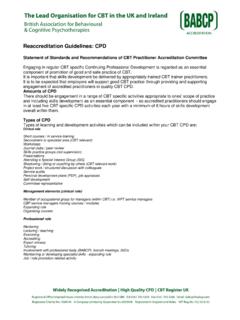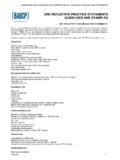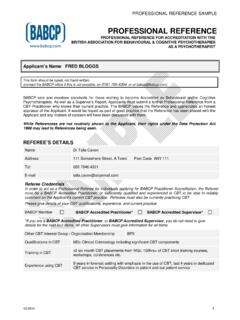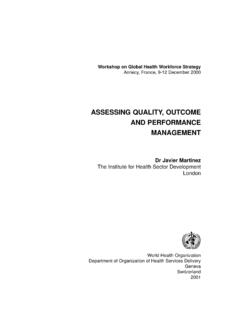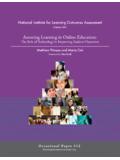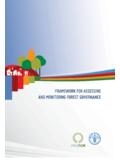Transcription of Guidelines for assembling and assessing KSA …
1 ACCREDITATION. Guidelines for assembling and assessing KSA portfolios or evidence for course assessment This document provides guidance on assembling and assessing core Knowledge, Skills and Attitudes (KSA) Portfolios, and evidence required for course assessment processes. KSA Applicants/Candidates are those who do not have a relevant recognised Core Professional training or qualification, and who must evidence how they meet this prerequisite requirement for further post-graduate (PG) training in Cognitive Behavioural Therapy (CBP). This document is for use by: Individuals assembling BABCP KSA Portfolios who are applying for Provisional Accreditation via the KSA route (Applicants). Individuals assembling KSA Evidence for Assessment during a BABCP Level 2 Accredited PG.
2 Diploma, including IAPT HI PG Diplomas (Candidates). BABCP Accreditors and BABCP Level 2 Accredited PG Diploma Training Course Selectors/Assessors for assessing an individual's KSA evidence If applicable, please also refer to the Guidelines for Level 2 Accredited Courses assessing KSA Candidates document, which provides additional information on assessing suitability for KSA candidates for your Level 2 Accredited PG CBP course, including IAPT HI PG Diploma. Widely Recognised Accreditation | High quality CPD | CBT Register UK. Contents 3 Introduction 4 Responsibility of the KSA Applicant/Candidate 4 Constructing a Portfolio or Evidence for Course Assessment 6 KSA Evidence 8 KSA Criteria (listed 1-14). 25 Example KSA Evidence forms 2.
3 Introduction It is recognised that the core Knowledge, Skills and Attitudes (KSA) expected of an individual as a precursor for undertaking formal PG training in CBP may be acquired by alternative routes to acquiring a traditional relevant recognised Core Professional qualification or training. Evidence of meeting the KSA criteria can be demonstrated by assembling a Portfolio or Evidence for Course Assessment, which can be made up of formal qualifications, formal and informal training, self-directed study, formal assessment of knowledge, skills and attitudes as demonstrated by course or job entry requirements, work related experience, and references attesting to knowledge, skills, competencies and attitudes. An individual meeting the relevant recognised Core Professional qualifications or trainings will usually have undertaken a first degree or foundation course, followed by post-graduate level of study.
4 It is therefore reasonable to expect that someone evidencing how they meet the KSA criteria should demonstrate equivalent levels of knowledge, skills, attitudes, competencies and experience. Relevant recognised Core Professional qualifications and trainings are considered to provide the foundation knowledge and skills that underpin all psychotherapeutic work. However, they vary in their attention to all aspects of the KSA criteria. How each training would match each criterion would be different if examining Clinical Psychology training, RMN training, or Psychiatry training, for example; if comparing these trainings, some would have strengths in some areas, and less weight in others although overall these are hefty full-time trainings that often take three to four years to complete.
5 It is therefore reasonable to assess a KSA individual across the whole KSA criteria, ensuring that not only is the minimum requirement for each one met, but that overall the training and experience evidenced equates to a considerable training. So an individual with a couple of years working as a Care Assistant may not have enough training and experience, for example, even if they do meet a minimum requirement for each of the KSA criteria. Those assessing KSA Portfolios or Evidence for Course Assessment exercise their professional judgement as to whether an individual has the foundation of knowledge, skills, attitudes, competencies and experience that underpin all psychotherapeutic work, and therefore are suitable for further specialist CBP training at PG level and work as a Cognitive Behavioural Psychotherapist.
6 3. Responsibility of the KSA Applicant/Candidate The KSA Applicant/Candidate is responsible for providing evidence of how they meet the KSA criteria, in lieu of a relevant recognised Core Professional training or qualification. This is a significant piece of work, which should be seen as a useful personal reflection and summary of historical training and experience, which has contributed to acquiring the foundation of knowledge, skills, attitudes, competencies and experience that underpin all psychotherapeutic work, and therefore evidence that they are suitable for further specialist CBP training at PG level and work as a Cognitive Behavioural Psychotherapist. It is worth noting that whilst this might seem to be a substantial task, this provides the Applicant/Candidate with an opportunity to evidence that they are suitably qualified to access training that would otherwise not be available to them in the absence of a relevant recognised Core Professional training or qualification.
7 Were they to have undertaken one of those Core Professional trainings, it is likely that they would have been required to undertake tasks or assignments which would have necessitated work similar or equivalent to assembling the KSA Portfolio. Constructing a Portfolio or Evidence for Course Assessment From this point forward the word Portfolio is used to describe the BABCP KSA Portfolio and the Evidence for Course Assessment material (which is likely to take the form of a Portfolio). For BABCP KSA Provisional Accreditation Applicants - template documents can be downloaded from the Accreditation section of the BABCP website, on the left-hand menu headed KSA'. For KSA Candidates on Level 2 Accredited courses (including IAPT HI courses) - you should obtain course personalised template documents from your course.
8 Template documents are designed to be completed electronically in Word, printed, and signed where appropriate. Hand written documents should be avoided where possible. The form KSA1 - Criterion Checklist should be placed at the front of the Portfolio, indicating that each criterion has been evidenced individually and appropriately. The Portfolio should be clearly broken down into the 14 criteria; making use of numbered tabs is advised. For each of the criterion, complete form KSA2 - Self-statement (not necessarily required separately if form KSA3 - Countersigned Self-statement is included as a Reference and attests to all claims made in the self-statement), which should state how the criterion have been met, and what supporting evidence can be found in the Portfolio, and where (either within the criterion section itself or at the back as a cross-referenced document).
9 You might provide more than one Countersigned Self-statement to verify all claims in an overall Self-statement as necessary. For the Self-statement for each criterion, refer to the Reference' requirement (found in the section KSA Criteria later in this document). A Self-statement or Countersigned Self-statement provides the opportunity to make a full summary of the following information: How the knowledge, skill and/or attitude was learned and acquired, for example where the training and/or experience was undertaken, through what trainings, in what work settings etc Briefly, what knowledge and/or skill was learned or acquired A critical appraisal of how this knowledge and/or skill applies to psychotherapeutic roles Illustrative example(s) of the application of the knowledge and/or skill which demonstrate some critical learning from the outcome Examples of Self-statements follow at the end of this document and demonstrate the quality of statement expected.
10 Only include relevant information within the Portfolio, so that is does not become of an unmanageable size. A. standard A4 1-2 inch lever-arch file should be sufficiently large enough if larger than this, it probably contains excessive information. 4. Please Note: your KSA Portfolio is scanned on receipt at BABCP office because its entire passage through the Accreditation process is managed electronically. Therefore please provide your KSA documentation: In your lever-arch file, hole punched Divided by numbered dividers, separators, tabs for each of the criteria As a continuous document of A4 pages within each section, preferably single-sided. Do not put documents in plastic wallets or separate folders Please Do not use other dividers/separators/tabs within the sections Do not use stick on tabs, labels, or Post-it notes Do not staple documents Do not use paper clips, or acco-clips Instead, please label your documents on the top right corner of the page, and cross-reference within your Portfolio, as instructed If necessary hand write any notes on the relevant additional page Information should be presented in a helpful way, so that Accreditors/Assessors can easily evaluate the information being evidenced, without the need for excessive cross referencing and hunting down' the relevant information for each criterion.
